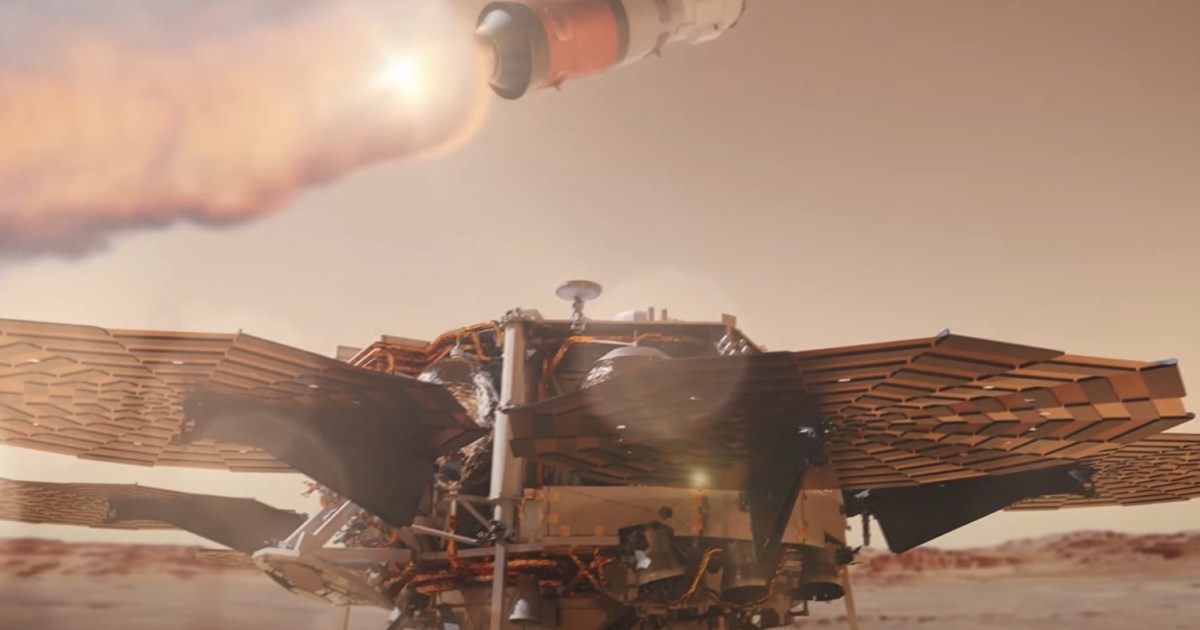When it comes to missions to Mars, NASA has been on a winning streak in recent decades. Its Spirit, Opportunity, Phoenix, Curiosity, InSight, and Perseverance missions have all landed successfully on the Martian surface, and we’re learning more than ever before about how to land on and explore the planet safely. The agency’s next plans for Mars, however, are a whole new level of ambitious. The Perseverance rover has been collecting samples of Mars dust and rock as it travels around, and the aim of the Mars Sample Return mission is to get those samples back to Earth.
The exact design of the mission has changed since it was first announced, but the current plan involves sending a lander to the surface called the Sample Return Lander (SRL) and then getting Perseverance to drop off the samples at this lander. Those samples will be loaded into a rocket inside the lander called the Mars Ascent Vehicle, which will launch into Mars orbit, where it will rendezvous with a spacecraft called the Earth Return Orbiter, which will bring those samples back to Earth.
If that sounds complicated, it’s because it is. No one has ever launched a rocket from the surface of another planet before, and for good reason. If landing on Mars is hard, then taking off from there is even harder. We spoke to two experts to find out why, and how NASA plans to engineer its way around it.
No launch pads on Mars
Stated most simply, the tricky part about trying to launch a rocket from another planet is that there are no launch pads on Mars. Launch pads provide a flat, stable surface from which a rocket can launch, and one which, importantly, won’t throw up material when the jets from powerful rocket engines hit it.
With a rocket firing its engines hard enough to take off from the ground, “the amount of energy that you have to blow out the back is gigantic,” explained Phil Metzger of the University of Central Florida, a launch pad expert who worked for NASA for many years. When that energy hits the surface of Mars, which is covered in a dusty material called regolith, the material being thrown up can cause serious problems and even damage the rocket itself.
A similar issue occurred during the landing of the Curiosity rover, for example. The descent stage, which was carrying the rover, had powerful engines around its edges. These blew downward to slow the descent during the final stage of landing.
That worked great for getting the rover onto the ground, but the power of the jet plumes threw up dust and small rocks with great force, one of which hit and disabled one of the rover’s wind sensors as it landed. Fortunately, the rover had a second wind sensor, so it was still able to take measurements, but the incident showed that landing on a dusty surface was no easy matter.
Beneath the surface
Another challenge is the stability of the ground beneath the vehicle as it lands. As surface material is thrown up and worn away, the rocket plumes can dig a crater into the planet’s surface.
How much of an issue that is really depends on what lies beneath. NASA’s Phoenix lander, for example, landed in the far north of the planet and blew away surface material to essentially land on a sheet of ice, which acted like a landing pad. That worked out great. When China’s Zhurong rover landed on Mars, however, its engines dug a deep, narrow hole into the surface beneath the landing vehicle.
“If you’re in very loose soil, while the rocket is blowing you’ll get a deep, narrow cylindrical crater which can then blow gas back up the cylinder at your vehicle. But as soon as the rocket engine shuts off, that crater collapses into a conical shape,” Metzger explained. The problem with this is that if the crater is wide enough, it can collapse soil beneath the legs of a lander, causing the lander to tip — and a tilted lander could make it impossible to deploy a rover or other instruments.
This process is hard to predict because it is thought to be related to the amount of water and ice in the soil. Not only do we not know the exact composition of the Martian subsurface in different regions, but also ice can melt over the seasons and could cause a collapse weeks or months after the landing.
Using the descent vehicle
So how does NASA plan to launch a rocket from Mars without blasting a hole or destroying it with debris?
Engineers will make use of something that will already be there: the descent vehicle. Just as the Apollo missions to the moon used the lunar lander to launch from, the Mars Sample Return mission will use the Sample Retrieval Lander as a base from which to launch a small rocket called the Mars Ascent Vehicle.
That means the lander needs some special design because it needs to do another job after it has brought the mission safely to the Mars surface: “This lander, unlike any lander before it, has another job after that,” Ray Baker, Sample Retrieval Lander Flight System Manager at NASA’s Jet Propulsion Laboratory, explained, “and that’s to launch after we’ve loaded samples into the Mars Ascent Vehicle.”
There are a couple of challenges with this. First, the rocket will not be pointing directly upward, because it could not fit inside the landing capsule that way. Including a crane-line gantry system to tilt it upright would be too heavy, so instead, it will rest on its side. The second issue is that the plume from the rocket engine could still interact with the surface around the lander and throw up material in a way that could be dangerous to the rocket.
The solution to both issues is ingenious, if seemingly bizarre: The lander will toss the rocket into the air, and the rocket’s engines will ignite while it is in mid-air to carry it into orbit.
The rocket is relatively small and light compared to the kinds of rockets we use to launch from Earth because Mars’s gravity is lower and the samples will have such a small amount of mass. The total mass of the rocket will be just over 1,000 pounds, so it’s feasible for a mechanism in the lander to push it into the air before its engines ignite.
The system, called VECTOR, is “like something from an amusement park,” Baker said. “You see all of the hydraulics at amusement parks, you can hear them when you ride the roller coaster or whatever, when they take you up or give you a lift. That’s what we’re doing. We have basically a gas generator that drives some pistons and throws this 1,000-pound thing up in the air, and then the rocket ignites and takes off.”
Scaling up a landing system
The complexity of this system brings up a new problem, though, and that’s the total mass of the lander.
Previous Mars missions have landed using systems like airbags, as the Opportunity and Spirit rovers did, or a jet-powered descent stage called a sky crane which lowers rovers to the surface on cables, as used for the Curiosity and Perseverance rovers. But there are mass limits to how much these systems can support, and recent rover landings were already pushing these limits.
The lander for MSR will be around 50% heavier than the Perseverance rover and its sky crane system combined, so the system has to be scaled up. The engines that will be used by the Sample Retrieval Lander will be roughly similar to those used on sky crane, but instead of eight, there will be 12 of them positioned on all sides of the lander.
Twelve big, powerful engines blowing out plumes, however, can cause the same cratering problems that a launching rocket can. So these engines are canted outward so that their plumes blow away from the lander’s legs, and the front of the vehicle where the Perseverance rover will need to approach to load the sample tubes.
“Canting is the number one thing,” to mitigate this issue, Baker said, but they have other plans too: “The other thing is time. It takes time to dig trenches and holes and so that’s why we come down relatively fast — 5 or 6 miles per hour. It doesn’t sound fast, but when you’re about to slam into the ground, it’s fast.”
It’s three or four times faster than Perseverance’s touchdown speed, and to handle the force of such a fast landing, the lander’s four landing legs are designed to bend and absorb the energy of the landing using devices called load limiters. This higher speed landing is to allow for the fact that the engines will be so much closer to the ground on the SRL than they were on the sky crane. The idea is that by having those engines blasting into the ground for a shorter period of time, they will disturb the surface less, making it less likely there will be issues once the lander has settled.
But just in case, the team has also learned from the destruction of Curiosity’s wind sensor that even with the best plans, there will still be debris being thrown around. Any sensitive components will be shielded to keep them safe, Baker said: “We’ll make sure that anything that is exposed is either something that we don’t need because we’re done using it, or it is protected.”
Mars gets a vote
Even with this new system, though, the Martian environment isn’t an easy one to conquer. A big problem for the launch of the rocket will be the stability of the ground on which the lander touches down.
“Mars gets a vote,” Baker said. “We could be on soft soil. We could be on bedrock. Or we could be on both, which actually turns out to be the hardest problem.” That’s because if the soil beneath the lander’s legs is consistent, then the force from tossing the rocket into the air will be evenly distributed. But if one side of the lander is on firmer ground and the other is on something softer, then the lander could tip as it pushes the rocket up, which could cause the rocket to launch in the wrong orientation.
To allow for this possibility, there are systems within the lander to give by varying amounts to mitigate the effects of unstable terrain.
“We have the science to guide us,”
There are also the same challenges of any Mars landing, such as variations in weather or the amount of dust in the atmosphere. With missions like Curiosity, InSight, and Perseverance collecting data on the Martian atmosphere and weather, there are better and better models of the planet’s changes throughout the seasons, but the conditions still can’t be predicted completely.
And then there is possible debris or obstacles on the ground which could be a danger to an incoming craft. The SRL will use a similar system as Perseverance’s Terrain Relative Navigation which used a camera on the descent vehicle to snap images of the surface as it came into land and highlighted potential safe landing areas, steering the craft towards those green zones.
But there’s a different problem for SRL: It has to land on one specific location, moving laterally across the surface to a particular destination which Baker described as “X marks the spot.” There’s far less wiggle room for the lander to pick a different landing location because the location needs to be somewhere that Perseverance can access to drop off its samples. That makes landing harder, but SRL does have one advantage: eyes on the ground. Perseverance can act as a scout before it has even launched, taking a survey of the landing site, and collecting imagery that can help with the SRL landing.
“So we have ground truth from Perseverance. We have the science to guide us,” Baker said. “And then we add a significant amount of margin to account for the unknown unknowns.”
A matter of political will
The launch and landing are just one component of the ambitious Mars Sample Return plan. We haven’t even touched on the challenges of getting a rocket to rendezvous with a craft in orbit and pass off the samples, and the need for everything to act autonomously as the communication delay between Earth and Mars means that the craft can’t be controlled directly.
The ambition of the plan is vast, and estimated costs for the mission are already climbing, leading to debate about whether the plan is realistic.
“It is extremely challenging and highly constrained, but it’s also worth doing.”
For Metzger, the technical challenges of the mission are considerable, but they could be overcome. The crux of the issue is, as always, money. “Do we have the political will to put the resources into the project to solve it in the timeframe?” he summed up the issue. “During Apollo, we had that political will,” and NASA was able to pull off an arguably more technically challenging mission within ten years because public and political support was behind it, but he isn’t sure if the same attitude prevails now.
Whether the political will coalesce behind MSR remains to be seen, but Baker’s team is ready for the challenge. “It is extremely challenging and highly constrained, but it’s also worth doing,” he said. “I worked on Perseverance, I’m very proud of that, and I feel like that was already a big step in the direction of Mars Sample Return. And I just can’t imagine not being a part of the team to follow through with it.”
Editors’ Recommendations

Dr. Sarah Adams is a scientist and science communicator who makes complex topics accessible to all. Her articles explore breakthroughs in various scientific disciplines, from space exploration to cutting-edge research.







